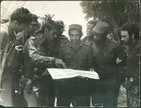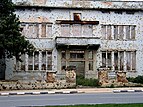| Angolan Civil War | |||||||
|---|---|---|---|---|---|---|---|
| Part of the Cold War (until 1991) | |||||||
| |||||||
| |||||||
| Belligerents | |||||||
|
Military advisers and pilots:
|
| ||||||
| Commanders and leaders | |||||||
| |||||||
| Strength | |||||||
|
| ||||||
| Casualties and losses | |||||||
|
|
| ||||||
| 800,000 killed and 4 million displaced[36] | |||||||
| Nearly 70,000 Angolans became amputees as a result of land mines[37] | |||||||
| History of Angola | ||||||||||||||||
|---|---|---|---|---|---|---|---|---|---|---|---|---|---|---|---|---|
 | ||||||||||||||||
|
||||||||||||||||
| Post-war Angola’s | ||||||||||||||||
| See also | ||||||||||||||||
| Years in Angola | ||||||||||||||||
The Angolan Civil War (Portuguese: Guerra Civil Angolana) was a civil war in Angola, beginning in 1975 and continuing, with interludes, until 2002. The war began immediately after Angola became independent from Portugal in November 1975. It was a power struggle between two former anti-colonial guerrilla movements, the communist People's Movement for the Liberation of Angola (MPLA) and the anti-communist National Union for the Total Independence of Angola (UNITA).
The MPLA and UNITA had different roots in Angolan society and mutually incompatible leaderships, despite their shared aim of ending colonial rule. A third movement, the National Front for the Liberation of Angola (FNLA), having fought the MPLA with UNITA during the Angolan War of Independence, played almost no role in the Civil War. Additionally, the Front for the Liberation of the Enclave of Cabinda (FLEC), an association of separatist militant groups, fought for the independence of the province of Cabinda from Angola.[citation needed] With the assistance of Cuban soldiers and Soviet support, the MPLA managed to win the initial phase of conventional fighting, oust the FNLA from Luanda, and become the de facto Angolan government.[38] The FNLA disintegrated, but the U.S.- and South Africa-backed UNITA continued its irregular warfare against the MPLA government from its base in the east and south of the country.
The 27-year war can be divided roughly into three periods of major fighting – from 1975 to 1991, 1992 to 1994 and from 1998 to 2002 – with fragile periods of peace. By the time the MPLA achieved victory in 2002, between 500,000 and 800,000 people had died and over one million had been internally displaced.[36][39] The war devastated Angola's infrastructure and severely damaged public administration, the economy, and religious institutions.
The Angolan Civil War was notable due to the combination of Angola's violent internal dynamics and the exceptional degree of foreign military and political involvement. The war is widely considered a Cold War proxy conflict, as the Soviet Union and the United States, with their respective allies Cuba and South Africa, assisted the opposing factions.[40] The conflict became closely intertwined with the Second Congo War in the neighbouring Democratic Republic of the Congo and the South African Border War. Land mines still litter the countryside and contribute to the ongoing civilian casualties.[36]
- ^ a b Shubin, Vladimir Gennadyevich (2008). The Hot "Cold War": The USSR in Southern Africa. London: Pluto Press. pp. 92–93, 249. ISBN 978-0-7453-2472-2.
- ^ Thomas, Scott (1995). The Diplomacy of Liberation: The Foreign Relations of the ANC Since 1960. London: Tauris Academic Studies. pp. 202–207. ISBN 978-1850439936.
- ^ Fitzsimmons, Scott (November 2012). "Executive Outcomes Defeats UNITA". Mercenaries in Asymmetric Conflicts. Cambridge University Press. p. 167. doi:10.1017/CBO9781139208727.006. ISBN 9781107026919.
- ^ Wolfe, Thomas; Hosmer, Stephen (1983). Soviet policy and practice toward Third World conflicts. Lanham: Rowman & Littlefield. p. 87. ISBN 978-0669060546.
- ^ a b c Hughes, Geraint (2014). My Enemy's Enemy: Proxy Warfare in International Politics. Brighton: Sussex Academic Press. pp. 65–79. ISBN 978-1845196271.
- ^ a b Weigert, Stephen (2011). Angola: A Modern Military History. Basingstoke: Palgrave Macmillan. pp. 151, 233. ISBN 978-0230117778.
- ^ Vanneman, Peter (1990). Soviet Strategy in Southern Africa: Gorbachev's Pragmatic Approach. Stanford: Hoover Institution Press. pp. 41–57. ISBN 978-0817989026.
- ^ Chan, Stephen (2012). Southern Africa: Old Treacheries and New Deceits. New Haven, Connecticut: Yale University Press. pp. 42–46. ISBN 978-0300184280.
- ^ Mitchell, Thomas G. (2013). Israel/Palestine and the Politics of a Two-State Solution. Jefferson: McFarland & Company Inc. pp. 94–99. ISBN 978-0-7864-7597-1.
- ^ Baynham, Simon (1986). Military Power and Politics in Black Africa. Abingdon: Routledge. pp. 216–219. ISBN 978-0367677275.
The Soviets provided direction, heavy lift and training staffs, the East Germans technical specialists ranging from helicopter pilots to medical personnel, and the Cubans a mass of soldiery...The next pattern was one of mixed Angolan and Cuban ground units, supported by East German-manned helicopters...[conditions dictated] the withdrawal of Cuban units to garrison roles, the actual ground fighting being left to Angolan units (now equipped with some very recent Soviet weaponry), very closely supported by East German and Russian training logistic cadres.
- ^ Brent, Winston (1994). African Military Aviation. Nelspruit: Freeworld. p. 12. ISBN 978-0958388016.
Besides arms and aircraft, large numbers of Russians, East Germans, and Cubans were brought into the country to bolster the Angolan armed forces...Although a number of locals were beginning to undertake combat sorties, most of the sorties were flown either by Cuban or East German pilots and crew.
- ^ a b James III, W. Martin (2011) [1992]. A Political History of the Civil War in Angola: 1974–1990. New Brunswick: Transaction Publishers. pp. 207–214, 239–245. ISBN 978-1-4128-1506-2.
- ^ Polack, Peter (13 December 2013). The Last Hot Battle of the Cold War: South Africa vs. Cuba in the Angolan Civil War. Casemate Publishers. pp. 66–68. ISBN 9781612001951.
- ^ "Brazil-South Africa Nuclear Relations | Wilson Center". www.wilsoncenter.org. Archived from the original on 31 March 2022. Retrieved 1 September 2021.
- ^ Selcher, Wayne A. (1976). "Brazilian Relations with Portuguese Africa in the Context of the Elusive "Luso-Brazilian Community"". Journal of Interamerican Studies and World Affairs. 18 (1): 25–58. doi:10.2307/174815. JSTOR 174815.
- ^ a b "Kwacha UNITA Press the National Union for the Total Independence of Angola UNITA Standing Committee of the Political Commission 1999 – Year of Generalised Popular Resistance – Communique No. 39/CPP/99". Federation of American Scientists. Archived from the original on 5 August 2022. Retrieved 3 December 2022.
- ^ Mason, Barry (16 November 1999). "Angola: MPLA inflicts new defeats on UNITA". World Socialist Website.
- ^ "IX. ARMS TRADE AND EMBARGO VIOLATIONS". Human Rights Watch. September 1999.
- ^ Steenkamp, Willem (2006) [1985]. Borderstrike! (Third ed.). Durban: Just Done Productions Publishing. pp. 102–106. ISBN 978-1-920169-00-8.
- ^ Saul David (2009). War. Dorling Kindersley Limited. ISBN 9781405341332. Retrieved 9 March 2013.
- ^ a b c "La Guerras Secretas de Fidel Castro" Archived 18 January 2012 at the Wayback Machine (in Spanish). CubaMatinal.com. Retrieved 9 March 2013.
- ^ Africa South of Sahara 2004, p. 66.
- ^ "Cuban Tanks • Rubén Urribarres". Cuban Aviation • Rubén Urribarres.
- ^ Gleijeses, Piero (2013). Visions of Freedom: Havana, Washington, Pretoria, and the Struggle for Southern Africa, 1976–1991. UNC Press Books. p. 521.
- ^ Risquet Valdés (2007: xlvii)
- ^ Risquet Valdés 2008: 102
- ^ Andrei Mikhailov (15 February 2011). "Soviet Union and Russia lost 25,000 military men in foreign countries". English pravda.ru. Retrieved 18 August 2013.
- ^ Irving Louis Horowitz (1995). Cuban Communism, 8th Edition. Transaction Publishers. ISBN 9781412820899. Retrieved 9 March 2013.
- ^ Angola – Independence Struggle, Civil War, and Intervention. MongaBay.com.
- ^ Political terrorism: a new guide to actors, concepts, data bases, theories and literature.
- ^ a b Clodfelter, Micheal (2017). Warfare and Armed Conflicts: A Statistical Encyclopedia of Casualty and Other Figures, 1492–2015, 4th ed. McFarland. p. 566. ISBN 978-0786474707.
- ^ Polack, Peter (2013). The Last Hot Battle of the Cold War: South Africa vs. Cuba in the Angolan Civil War (illustrated ed.). Oxford: Casemate Publishers. pp. 164–171. ISBN 978-1612001951.
- ^ "Soviet Union and Russia lost 25,000 military men in foreign countries – English Pravda". English.pravda.ru. 15 February 2011. Retrieved 18 August 2013.
- ^ Akawa, Martha; Silvester, Jeremy (March 2012). "Journal for Studies in Humanities and Social Sciences" (PDF). Windhoek, Namibia: University of Namibia. Archived from the original (PDF) on 10 November 2016. Retrieved 2 September 2023.
{{cite web}}: CS1 maint: date and year (link) - ^ Reginald Herbold Green. "Namibia : The road to Namibia – Britannica Online Encyclopedia". Britannica.com. Retrieved 15 January 2013.
- ^ a b c "Angola (1975–2002)" (PDF). Archived from the original (PDF) on 25 October 2020. Retrieved 17 July 2020.
- ^ Armed Conflict and Environmental Damage. 2014. p. 98.
- ^ Africa, Problems & Prospects: A Bibliographic Survey. U.S. Department of the Army. 1977. p. 221.
- ^ Refugees, United Nations High Commissioner for (4 December 2000). "Refworld | Angola: Current political and human rights conditions in Angola". Refworld. Archived from the original on 26 March 2020. Retrieved 26 March 2020.
- ^ "Angola General Conflict Information". Uppsala Conflict Data Program. Archived from the original on 18 December 2014. Retrieved 5 June 2013.
Cite error: There are <ref group=note> tags on this page, but the references will not show without a {{reflist|group=note}} template (see the help page).



